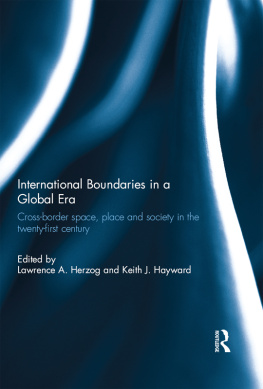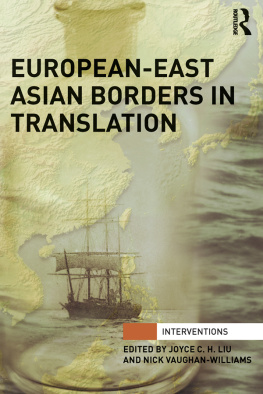Introduction
This publication on Cross-border Circulation and Networks in the European Space is an attempt to enlarge the perspectives of Contemporary European Border Studies both temporally and epistemologically. For, whereas there has been a multidisciplinary opening up of this field of study, there is still a large restriction with regard the time periods and topics covered. Border studies in Europe are indeed mostly related to the field of cross-border cooperation and its relationship with the process of European integration after the Second World War. They are therefore more focused on border regions, cross-border actors and their governance structures from1945 onwards than on the general circulation of ideas and thought regarded from a long-term historical perspective.
Border Studies have indeed developed in recent years as a growingly attractive research field for many disciplines in Human Sciences.
However, the main priority for scholars in European Border studies has been so far the development of cross-border cooperation with regard to European integration. From the 1980s, the first case studies on cross-border regions in Western Europe were published, which had started cooperation in the late 1950s or at the beginning of the 1960s. Empirical research was led for example on Franco-German cross-border cooperation (Saar-Lor-Lux) or on the Upper Rhine border region.
What is generally missing in these approaches is the consideration that networks can also be built across borders because there is a community of ideas or a shared good to defend: a common scientific culture, health, environment, etc. The circulation of thought, ideas and identities has therefore been at the origin of a doctoral seminar which was organized on 10-11 January 2019 in Strasbourg on Cross-border circulation and networks in the European space (18 th -21 rst century): a trans-periodical approach. It was co-organized by the historian Beata Halicka form the University of Poznan and supported by the European Commission, within the Erasmus + Jean Monnet project on Crises in European Border Regions. The communications presented by the doctoral students ranged from the news diffusion and translation phenomenon in the Upper rhine periodical press at the beginning of the French Revolution (1791) to cross-border networks of Germans in Upper Silesia (1930s) or the question of Poles as a national minority in Belarus (1990s). The doctoral seminar was then coupled with several case-studied collected by Martine Camiade from the Institut dEstudis Catalan (IEC) on the Franco-Spanish cross-border region, which examined linguistic communities, health care networks, territorial diplomacy and the tools of cross-border law. Both projects led to this present publication which puts an emphasis on several types of circulation and networks in cross-border spaces. On the one hand, on the circulation of ideas (anti-fascism in the inter-war period), the circulation of people (visa regulations between Poland and Belarus), the circulation of scientific culture (among the universities of the Upper Rhine Region), of languages (in the Catalan Region) and of law (legal cross-border tools). On the other hand, on networks of environmental cooperation in the Upper Rhine Region, of health care with the example of the Franco-Spanish cross-border hospital in Cerdayna and of para-diplomacy in Andorra and in Catalonia.
Francesca Tortorella, in her article on Beyond Borders: The Ideal Anti-Fascist Homeland. European Unity and Anti-Fascism starts by giving voice to another idea of crossing the border, which is not geographical, but seen rather seen from the perspective of circulation of an ideal. By focusing on the Europe of the 1930s and 1940s and analysing the European evolution of a democratic anti-fascism, she shows how the ideal that united the anti-fascists was far stronger than any national bond. The Europeanist thought of a leftist, socialist and liberal intellectual environment, in particular the Italian anti-fascist movement, Giustizia e Libert , founded in Paris in 1929 by anti-fascists in exile constituted for them an ideal, anti-fascist homeland. For this very particular anti-fascist milieu , the struggle went beyond borders. Thus, the post-war projects claimed for the political unity of Europe: to free Europe from Nazi-fascism and to federalize the post-war Europe in order to give a sound basis to peace. The values of the ideal Europe depicted by these anti-fascists in radical opposition to fascist and Nazi Anti-Europe were part of a common heritage that goes beyond borders.
The circulation of people is a subject dealt with by Anna Kuleszewicz who examines, at the Polish-Belarusian border, The Impact of Visa and Visa-Free Traffic on Border-Crossing. She shows that circulation in the form of visa-free travel between Poland and Belarus has deteriorated with Polands accession to the EU and to the Schengen Area. Whereas the EU advocates a borderless Europe marked by free mobility of people, this does not count for the external borders and their border population. Relations between the Belarusian and Polish authorities, as well as with the EU, have therefore been complicated, especially since the authoritarian rule of Alexander Lukashenka which has caused the EU to impose sanctions and further restrict cross-border relations. However, although the introduction of a visa regime significantly impeded the border flows between Poland and Belarus, it can be noticed that this did not actually discourage people from crossing the border, as the number of border crossings has still been constantly increasing. The author believes that this is because circulation, i.e. moving around the borderland area and establishing relationships (social, political, economic) in the cross-border region is a natural phenomenon for the people living there. According to her, the implementation of effective cross-border policy mechanisms between Poland and Belarus could enable these natural circulation flows to accelerate and help the future development of cross-border cooperation at Eastern European borders.
In her article on Cross-Border Cooperation of the Universities in the Upper Rhine Valley. Between the 1960s and 2010s: Towards a Transnational University? , Elen Guy then retraces the circulation of science and the building of a transnational scientific community between the universities of the Upper Rhine Region. She demonstrates, that despite the legacy of the Franco-German wars, relationships between the University of Freiburg, the University of Basel and the University of Strasbourg have been maintained after 1945 thanks to the personal contacts which were kept intact independently of the international political climate. Personal networks permitted to continue the transnational relationship between the universities but the nature of these networks has changed in time. Elen Guy thus remarks, that at the beginning, in 1962, relations were mainly informal exchanges of researchers who met to exchange ideas or concepts, but that from the 1980s, cross-border research took on an eminently more political character becoming a centre of interest also for institutional cooperation. In a context of economic crisis, circulation of thought was no longer sufficient: the regional and local authorities of the Upper Rhine worried about the competitively of their universities and engaged in scientific cooperation to increase their economic performance. From the 1990s and 2000s onwards, this type of cooperation was further strengthened by use of Interreg funds for the implementation of common projects and by the creation a scientific pillar of the Metropolitan Upper Rhine Region (RMT). The transnational scientific community therefore has moved from an informal network facilitating the circulation of concepts and ideas to an institutionalized structure of cooperation aiming at increasing (world) competitiveness in the scientific field.













